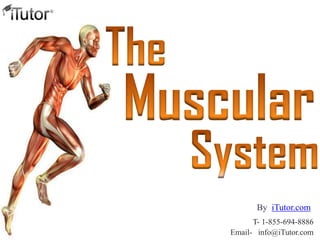
The Muscular System
- 1. T- 1-855-694-8886 Email- info@iTutor.com By iTutor.com
- 2. The muscular system is a complex collection of tissues, each with a different purpose. Understanding the components of the muscular system, including the various types of connective tissues, is a good way to understand how bodies and physical movement work. © iTutor. 2000-2013. All Rights Reserved
- 3. Body movement (Locomotion) Maintenance of posture Respiration – Diaphragm and intercostal contractions Communication (Verbal and Facial) Constriction of organs and vessels – Peristalsis of intestinal tract – Vasoconstriction of b.v. and other structures (pupils) Heart beat Production of body heat (Thermogenesis) © iTutor. 2000-2013. All Rights Reserved
- 4. Excitability: capacity of muscle to respond to a stimulus. Contractility: ability of a muscle to shorten and generate pulling force. Extensibility: muscle can be stretched back to its original length. Elasticity: ability of muscle to recoil to original resting length after stretched. © iTutor. 2000-2013. All Rights Reserved
- 5. © iTutor. 2000-2013. All Rights Reserved
- 6. Skeletal – Attached to bones – Makes up 40% of body weight – Responsible for locomotion, facial expressions, posture, respiratory movements, other types of body movement – Voluntary in action; controlled by somatic motor neurons Smooth – In the walls of hollow organs, blood vessels, eye, glands, uterus, skin – Some functions: propel urine, mix food in digestive tract, dilating/constricting pupils, regulating blood flow, – In some locations, auto rhythmic – Controlled involuntarily by endocrine and autonomic nervous systems Cardiac – Heart: major source of movement of blood – Auto rhythmic – Controlled involuntarily by endocrine and autonomic nervous systems © iTutor. 2000-2013. All Rights Reserved
- 7. © iTutor. 2000-2013. All Rights Reserved
- 8. Muscle attachments – Most skeletal muscles run from one bone to another. – One bone will move – other bone remains fixed. Origin – less movable attachment. Insertion – more movable attachment. © iTutor. 2000-2013. All Rights Reserved
- 9. Muscle attachments (continued) – Muscles attach to origins and insertions by connective tissue Fleshy attachments – connective tissue fibers are short. Indirect attachments – connective tissue forms a tendon or aponeurosis. – Bone markings present where tendons meet bones Tubercles, trochanters, and crests. © iTutor. 2000-2013. All Rights Reserved
- 10. Composed of muscle cells (fibers), connective tissue, blood vessels, nerves. Fibers are long, cylindrical, and multinucleated. Tend to be smaller diameter in small muscles and larger in large muscles. 1 mm- 4 cm in length. Develop from myoblasts; numbers remain constant. Striated appearance. Nuclei are peripherally located. © iTutor. 2000-2013. All Rights Reserved
- 11. © iTutor. 2000-2013. All Rights Reserved
- 12. SR is an elaborate, smooth endoplasmic reticulum – runs longitudinally and surrounds each myofibril – Form chambers called terminal cisternae on either side of the T- tubules A single T-tubule and the 2 terminal cisternae form a triad SR stores Ca++ when muscle not contracting – When stimulated, calcium released into sarcoplasm – SR membrane has Ca++ pumps that function to pump Ca++ out of the sarcoplasm back into the SR after contraction © iTutor. 2000-2013. All Rights Reserved
- 13. © iTutor. 2000-2013. All Rights Reserved
- 14. Many elongated myosin molecules shaped like golf clubs. Single filament contains roughly 300 myosin molecules. Molecule consists of two heavy myosin molecules wound together to form a rod portion lying parallel to the myosin myofilament and two heads that extend laterally. Myosin heads 1. Can bind to active sites on the actins molecules to form cross-bridges. (Actin binding site) 2. Attached to the rod portion by a hinge region that can bend and straighten during contraction. 3. Have ATPase activity: activity that breaks down adenosine triphosphate (ATP), releasing energy. Part of the energy is used to bend the hinge region of the myosin molecule during contraction © iTutor. 2000-2013. All Rights Reserved
- 15. Tropomyosin Tropoin Actin Myosin © iTutor. 2000-2013. All Rights Reserved
- 16. Thin Filament: composed of 3 major proteins 1. F (fibrous) actin 2. Tropomyosin 3. Troponin Two strands of fibrous (F) actin form a double helix extending the length of the myofilament; attached at either end at sarcomere. – Composed of G actin monomers each of which has a myosin- binding site (see yellow dot) – Actin site can bind myosin during muscle contraction. Tropomyosin: an elongated protein winds along the groove of the F actin double helix. Troponin is composed of three subunits: – Tn-A : binds to actin – Tn-T :binds to tropomyosin, – Tn-C :binds to calcium ions. © iTutor. 2000-2013. All Rights Reserved
- 17. Cells are not striated Fibers smaller than those in skeletal muscle Spindle-shaped; single, central nucleus More actin than myosin No sarcomeres – Not arranged as symmetrically as in skeletal muscle, thus NO striations. Caveolae: indentations in sarcolemma; – May act like T tubules Dense bodies instead of Z disks – Have noncontractile intermediate filaments © iTutor. 2000-2013. All Rights Reserved
- 18. © iTutor. 2000-2013. All Rights Reserved
- 19. Grouped into sheets in walls of hollow organs. Longitudinal layer – muscle fibers run parallel to organ’s long axis. Circular layer – muscle fibers run around circumference of the organ. Both layers participate in peristalsis. © iTutor. 2000-2013. All Rights Reserved
- 20. Found only in heart where it forms a thick layer called the myocardium. Striated fibers that branch Each cell usually has one centrally-located nucleus Fibers joined by intercalated disks – IDs are composites of desmosomes and gap junctions – Allow excitation in one fiber to spread quickly to adjoining fibers Under control of the ANS (involuntary) and endocrine system (hormones) Some cells are autorhythmic – Fibers spontaneously contract (aka Pacemaker cells) © iTutor. 2000-2013. All Rights Reserved
- 21. © iTutor. 2000-2013. All Rights Reserved
- 22. The end Call us for more Information: www.iTutor.com 1-855-694-8886 Visit